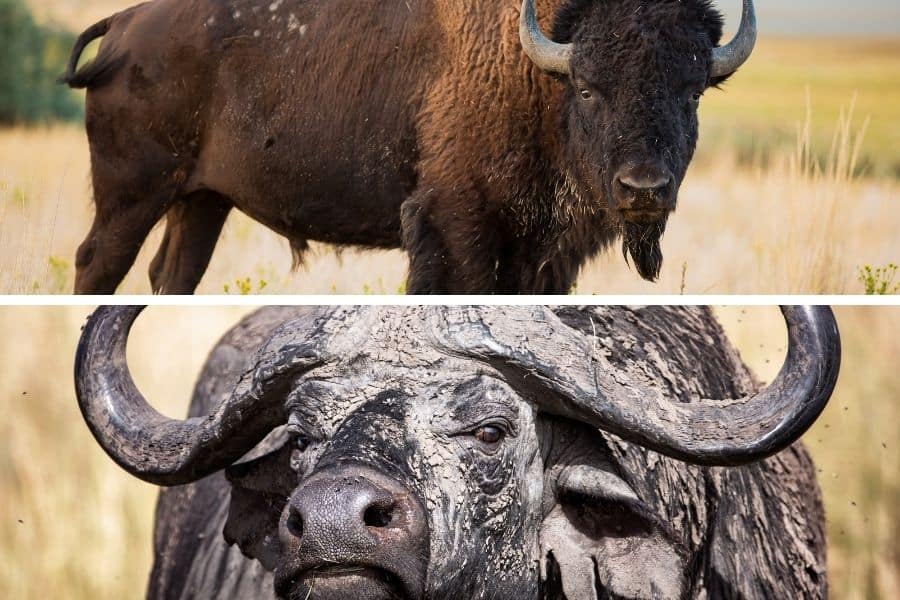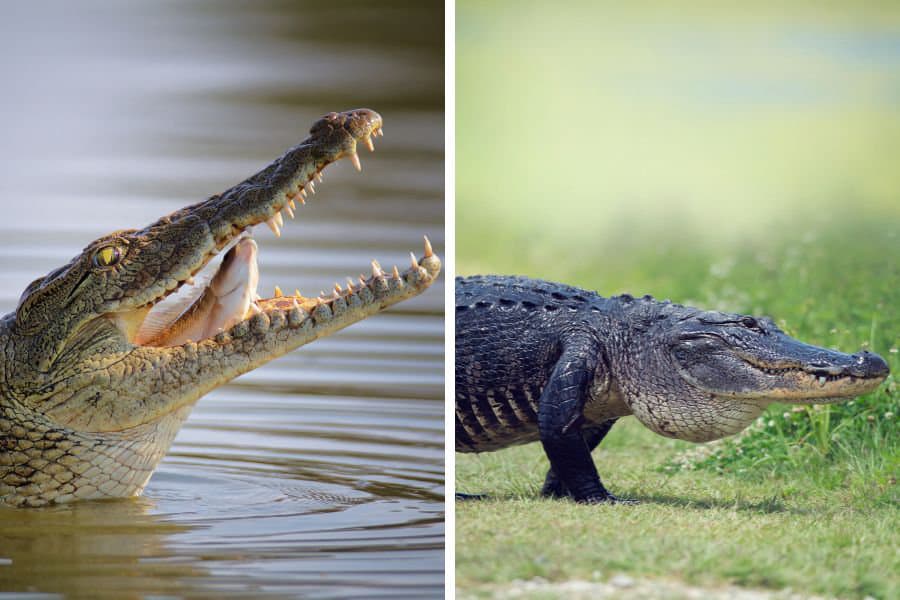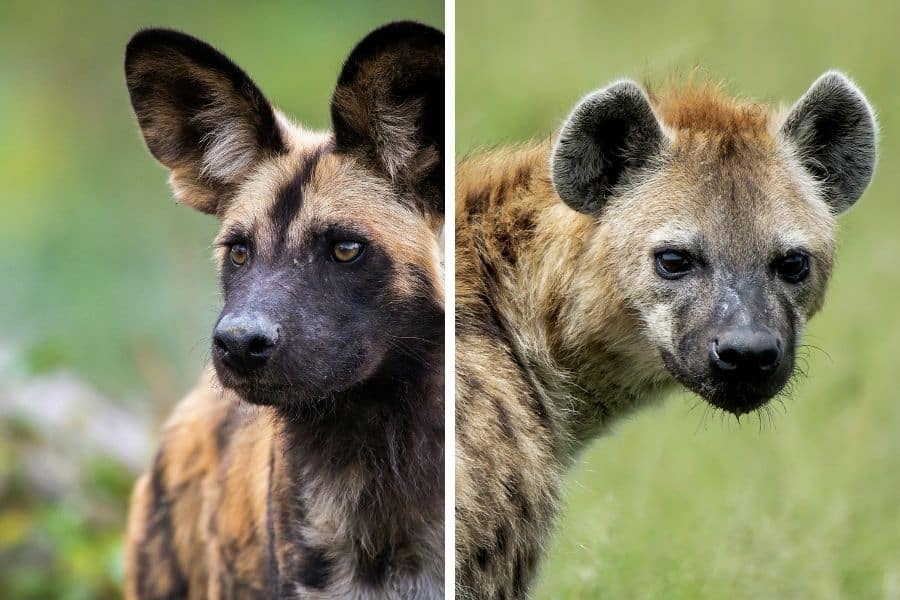There’s an old American folksong that goes “Oh give me a home/ where the buffalo roam…” And that’s where everything stops making sense. Because what they were talking about weren’t buffalo at all. What the early immigrants called buffalo are actually bison. But hey, how were they to know better?
Fortunately, we do today. And here’s the guide to what makes buffalo and bison different, what similarities they share, and why it’s ok (kind of) to sing that old song anyway.
So, What is the Difference Between a Bison and a Buffalo?

To be fair, both bison and buffalo are part of the Bovidae family. Those early American settlers probably mistook the North American bison for what was either a relative of the Asian water buffalo or more likely the African or Cape buffalo.
The names indicate an immediate clue: water buffalo exist primarily in Asia, and African buffalo, well, in Africa. The bison is primarily a North American phenomenon.
In the early days of American colonisation, settlers called bison buffalo, probably due to their similar look. In some regions, the confusion still persists, at least in the name.
Here’s a fun fact: there is a small pocket of bison in eastern Europe – Poland, to be exact. Their numbers are very slowly starting to spread across Europe.
Scientific Names – Type of Buffalo & Bison
The scientific names for the species also indicate a clear difference in the animals, specifying that they are not that closely related to buffalo at all. In fact, there are a few types of buffalo who are not that closely related, either:
- Cape buffalo – Syncerus caffer
- Wild Asian water buffalo – Bubalus arnee
- Domestic Asian water buffalo – Bubalus bubalis
- North America bison – Bison bison
- European bison – Bison bonasus
It’s most likely that the bison got confused with the Cape buffalo by those American settlers, as they are most similar in size and description. So we’ll concentrate on those two for the most part. Now let’s get into comparisons.
1. They Live On Different Continents
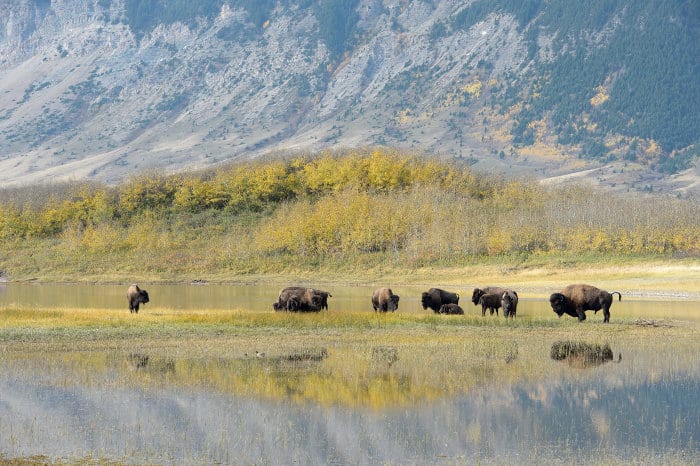
Bison once roamed the great plains of North America in their millions. They migrated from as far north as Alaska to Northern Mexico. In the 19th and 20th century traders massacred bison by the thousands for their valuable coats and hides.
Some estimate that bison occupy only 1 percent of their former territory today.
Cape buffalo graze in the sub-Saharan region of Africa. Large populations still exist in eastern and southern Africa. Generally, they stay close to water sources.
2. Buffalo vs Bison Horns
There is an obvious way to tell a bison from a Cape buffalo at a glance. The horns. Cape buffalo horns are large and curve outward like an old-timey moustache that curls upwards at the ends.
These horns can grow to over a metre across. You may also notice that part of the horn structure contains a bone shield across the head. Cape buffalo was never tamed or domesticated, and are unpredictably aggressive. So don’t tangle with them. They are formidable beasts.
Water buffalo have even bigger horns, averaging almost 1.5 m across.
Bison horns are much smaller, but sharper. They average around 60-70 cm across in length.
3. Size Difference Between Bison and Buffalo
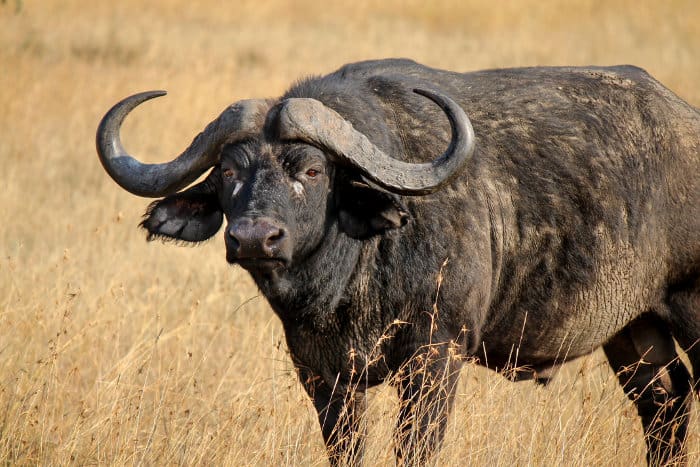
If it’s a big old beast with a huge, furry head and a big hump behind its front shoulders, chances are it’s a bison. Bison are bigger than buffalo on average, but not by much. Large bison bulls grow to around 3.5 m (11.5 feet) in length. They can easily weigh 1000 kg, sometimes even more.
Buffalo, by comparison, are more “normal” shaped. Their heads are smaller and they have no hump to speak of. Big African buffalo measure about 3.3 m and weigh around 900 kg.
A wild water buffalo may be smaller in stature at 2.7 m in length, but is way heavier (1200 kg). That’s a true workhorse! Or rather, work buffalo.
4. Body Shape
Besides those large humps on their backs, bison have significantly bigger heads than buffalo. It gets worse. They also have thick, shaggy beards covering their heads and faces. They look a little lighter in the summer because they shed much of it.
It makes the bison look a little misshapen – a big bulky front, with seemingly smaller hindquarters.
A buffalo shape, by comparison, is more uniform. Their heads are smaller and they have no hump to speak of. This makes them look more even, as it were.
5. Diet

Bison graze all year round on grasses and plants. They may also taste moss and lichen, and the leaves of some woody plants. They are specially adapted to snowy winters. In snowy areas, you’ll find bison sweeping their heads from side to side. This is to clear snow from the ground, in search of food.
Buffalo also eat most grass and plants. Their adaptation is to water, though, not snow. In fact, they’re seldom far from a water source. They love a good water-based plant. In desperate times, they will also tackle a tasty tree and a shrub.
6. Difference Between Buffalo and Bison Hair and Coats
It gets cold on the great plains of the Americas. Bison, therefore, have incredibly thick coats and hides. This is what made them desirable targets for hunters back in the 19th and 20th centuries. They do shed the thicker coats in summer.
Buffalo do not shed, given that their coats are thinner. It’s generally hotter in Asia and Africa, anyway.
There’s also a difference in facial hair. Bison have thick, shaggy beards. Buffalo prefer to be clean-shaven. Just kidding. They do not grow beards. 😉
7. Who is Faster?
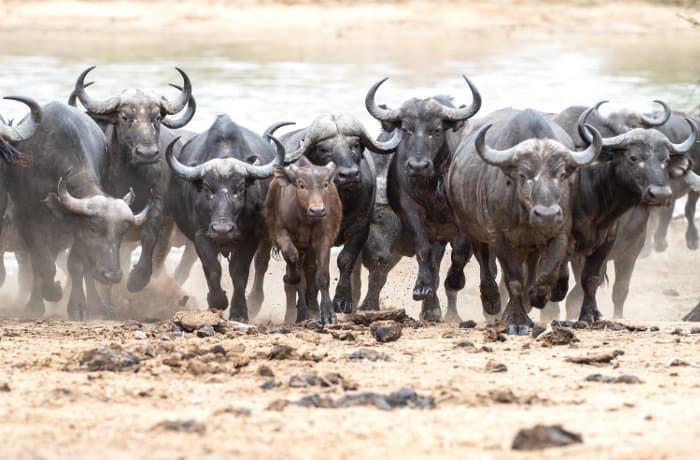
Out of the blocks, it’s bison that can outrun buffalo. The bison is an impressive runner, running slightly faster than a race horse at up to 64 km/h.
They are also surprisingly agile and can turn on a dime, as Americans might say. They can leap tall fences, too. You might say it’s the Superman of Bovidae, if it didn’t sound so silly. 🙂
Buffalo can run fast, too… even if it is usually a bit slower than bison. Really, the difference is marginal. Don’t make the mistake of thinking they’re slouches, just because they look bulky and awkward with those big horns.
The thing about a buffalo is, it doesn’t really like an intrusion. And it’s very hard to tell when it’s going to lose its temper.
Buffalo can suddenly charge at you without warning. Their impressive superpower is acceleration. They can go from 0 to top speed in under three seconds.
The best advice? Stay in the vehicle.
8. State of the Bison and Buffalo Populations
The history of bison is strongly linked to the destruction of the Native American lifestyle. As the US government ratified and allowed the systematic slaughter of the animals, the landscape and livelihood of the native people were forever changed.
Estimates put the number of bison up to 100 million in 1800, down to as little as 1000 in 1980. Today they exist mainly as cultivated livestock. In the wild, around 30 000 falls under a conservation status.
There exists now an estimated 400 000 African buffalo on the continent according to the most recent estimates. Their main challenges involve loss of habitat due to urbanisation and environmental damage. Their cause is not helped by their reputation for being aggressive.
Weird Bonus Facts About Bison and Buffalo
Here are a few extra facts about bison and buffalo that may seem somewhat bizarre:
Bison

- A funny local name for a baby bison is a “red dog”. They come out all red and orange at birth, and change colour to the expected brown later on.
- Bison have existed in what is now Yellowstone National Park since prehistoric times.
- Bison is the biggest North American land mammal.
- Bison live up to 10-20 years on average.
- Judge a bison’s intention by watching its tail. A rigid tail is a bad sign. A relaxed, downward tail means you’re ok.
- Male bison are bulls, and females are cows.
- They don’t see well, but have an acute sense of smell.
Buffalo
- Buffalo horns fuse in the middle. In males, an extra shield forms from the joining horns here at its base, and forms a “boss”! Females do not have a boss.
- Horn size is a pretty good indicator of who the dominant individuals are. The bigger the horn, the bigger the boss, so to speak.
- Hunters used to call buffalo The Black Death and The Widowmaker. This is because they are extremely dangerous to hunt, and they are unpredictable. It’s also why they’re one of the African Big Five.
We Know Where the Buffalo Are!
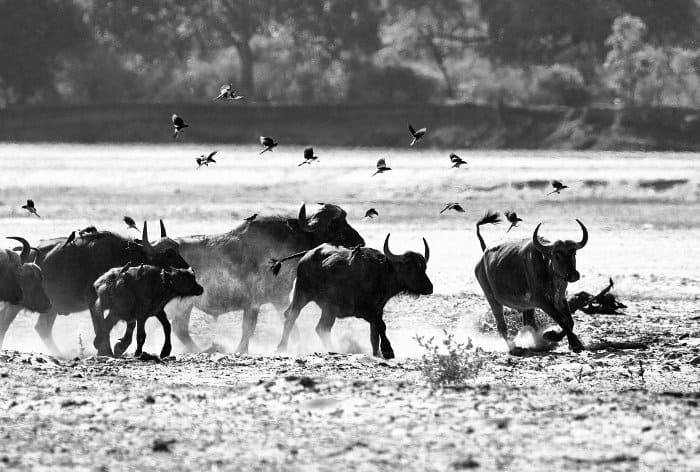
Bison or buffalo, they’re both beautiful. You’ll have to go to the USA to see the bison. But in Africa, you can see plenty of buffalo, along with several other amazing mammalian species like big cats, antelope, and even elephants. You can see them all by booking an African safari, and ask where the buffalo are!
